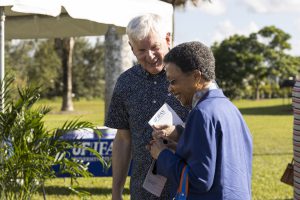Because of the era and the color of her skin, Pauline Lawrence had to do more than make discoveries to amass a distinguished scientific career. She had to make history.
Lawrence arrived in Gainesville in 1969, just 11 years after UF had admitted its first Black student. When she went to Homestead in 1973 to pursue a Ph.D., she became the first Black female entomology graduate student and first female to live and study at the Tropical Research and Education Center.
As a student who couldn’t afford Miami-area housing prices even 50 years ago, having an affordable dorm room at TREC meant she had money for food and the laundromat. It kept her near her research.
And, I think it’s important to say, it kept her safe from the hazards a woman of her age may have been subject to had she lived outside the protective cocoon of an isolated research station.

Right thing, smart thing
She also had a mentor who made TREC a home for her. Professor Richard Baranowski and his family had Lawrence over to their home for dinner and regularly checked on how she was doing, not just what she was doing.
This support for Lawrence was, of course, the right thing to do. It was also, from the point of view of the advancement of science, the smart thing to do.
Had Lawrence not studied here, she likely would not have joined our faculty. She may not have discovered a virus in wasps that destroys the immune system of fruit fly pests and provided added scientific basis for the expanded use of one of the world’s most effective biological control agents for tephritid fruit flies worldwide. She would not have attracted millions of dollars in National Science Foundation and U.S. Department of Agriculture funding to UF/IFAS that advanced the basic science that underpins pest control and promoted the careers of numerous undergraduate and graduate students and postdoctoral associates.
And she would not be in the position she’s in today as benefactor and philanthropist, who along with her husband, Professor Carlton Davis (also a history maker as UF/IFAS’s first Black faculty member and distinguished service professor), established a scholarship fund nearly 20 years ago.
Nor would she have made the anchor donation to build a place at TREC for generations of future students to live, study and pursue their dreams. During Black History Month, I wanted to acknowledge how in making this gift, Lawrence yet again makes history.

A historic first
The Pauline O. Lawrence Student Residence will be the first building in the history of the University of Florida named for a Black person. UF/IFAS finally acknowledges in brick and mortar, not just in lip service, the contributions of a Black faculty member, and indeed of African-Americans broadly, in building our university into a world-class institution.
The naming of a dorm doesn’t expiate our past exclusion. But it does inspire us to do better. With the naming, we take an important step forward on UF/IFAS’s journey toward becoming a more inclusive institution.
The real change, though, has to be in each of us, in our hearts. We need to be more welcoming like Richard Baranowski and his family and more determined like Pauline Lawrence. We need to find more Pauline Lawrences, hire them, support them, invite them into the scientific community.
The Pauline O. Lawrence Student Residence will stand as a permanent reminder that when we extend opportunity to previously excluded people, all of us are better for it.
 1
1
